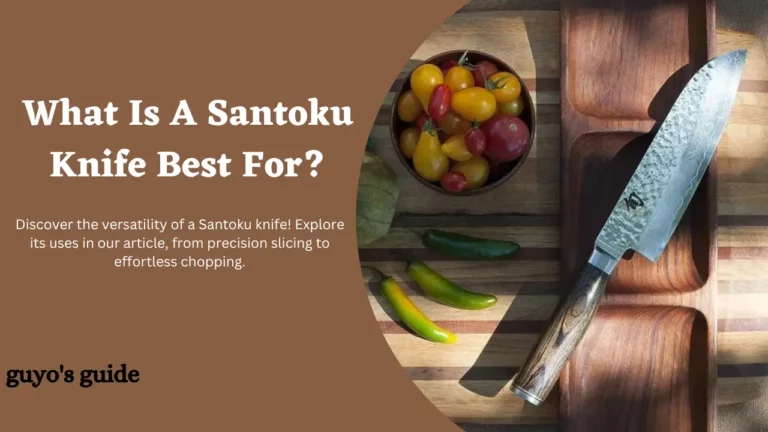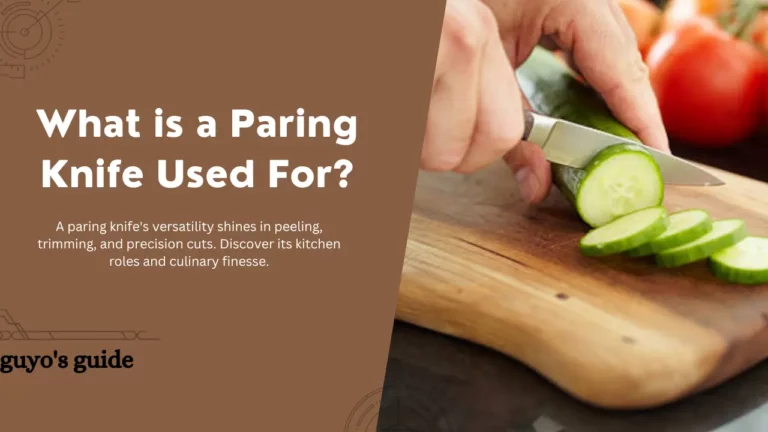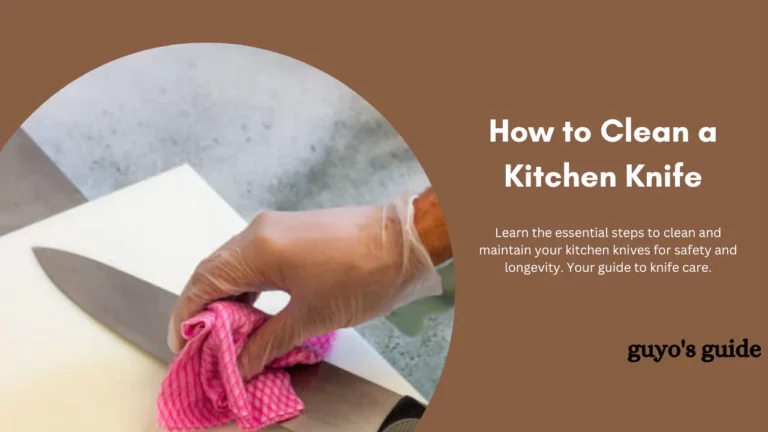Boning Knife vs. Chef Knife (Comparison)
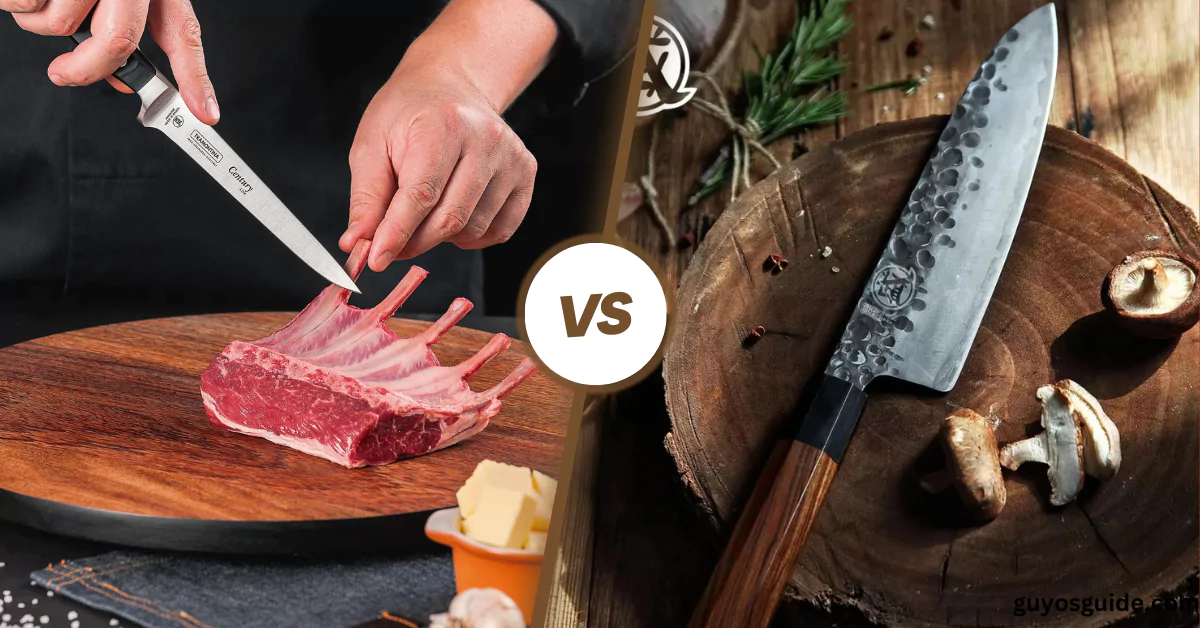
Some of the links in this post are affiliate links, meaning, at no additional cost to you, We will earn a commission if you click through and make a purchase.

When it comes to the kitchen, having the right tools is essential for success. Two popular choices for slicing and dicing are the boning knife and the chef knife.
While they may seem similar at first glance, there are distinct differences that make each knife unique.
In this blog post, we will explore the characteristics of both the boning knife and the chef knife, helping you decide which one is the best fit for your culinary needs.
Let’s get started.
Boning Knife

A boning knife is a specialized kitchen knife designed for the precise removal of bones from meat, poultry, and fish.
Its primary purpose is to separate the meat from bones with accuracy, minimizing waste, and ensuring clean cuts.
The boning knife is characterized by its narrow, pointed blade, which allows for detailed and controlled bone removal.
Description of the Unique Features and Design
The boning knife’s design sets it apart with several distinct features:
- Blade Shape: Boning knives typically have a narrow, pointed blade that varies in flexibility, ranging from stiff to semi-flexible. The flexibility of the blade can be chosen based on the specific task at hand, offering versatility in the kitchen.
- Blade Length: Boning knife blades are usually 5 to 7 inches (13 to 18 cm) in length, making them shorter than many other types of knives. This shorter length provides precise control.
- Blade Thickness: Boning knife blades are relatively thin, allowing for precise and delicate cuts. The thin blade minimizes resistance when working around bones.
- Handle: The handle of a boning knife is often designed with a secure and ergonomic grip, ensuring the user has full control over the blade.
Explanation of the Specific Tasks a Boning Knife is Best Suited For:
Boning knives are versatile tools in the kitchen and excel at various tasks, including:
- Deboning Meat: Their precision and narrow blade make them ideal for removing bones from cuts of meat, such as beef, pork, or poultry. They are particularly useful for intricate tasks like deboning chicken thighs or filleting fish.
- Removing Poultry Skin: Boning knives can also be employed to remove poultry skin with precision, ensuring that the skin is cleanly separated from the meat.
- Filleting Fish: Many boning knives have a semi-flexible blade, making them excellent for filleting fish. The flexibility allows the blade to follow the contours of the fish while maintaining control.
- Trimming Fat: Boning knives are often used to trim excess fat from meat, creating leaner cuts.
- Detail Work: Their narrow and pointed blades make them useful for various detail work in the kitchen, such as trimming silver skin or working on small, delicate tasks.
Chef Knife
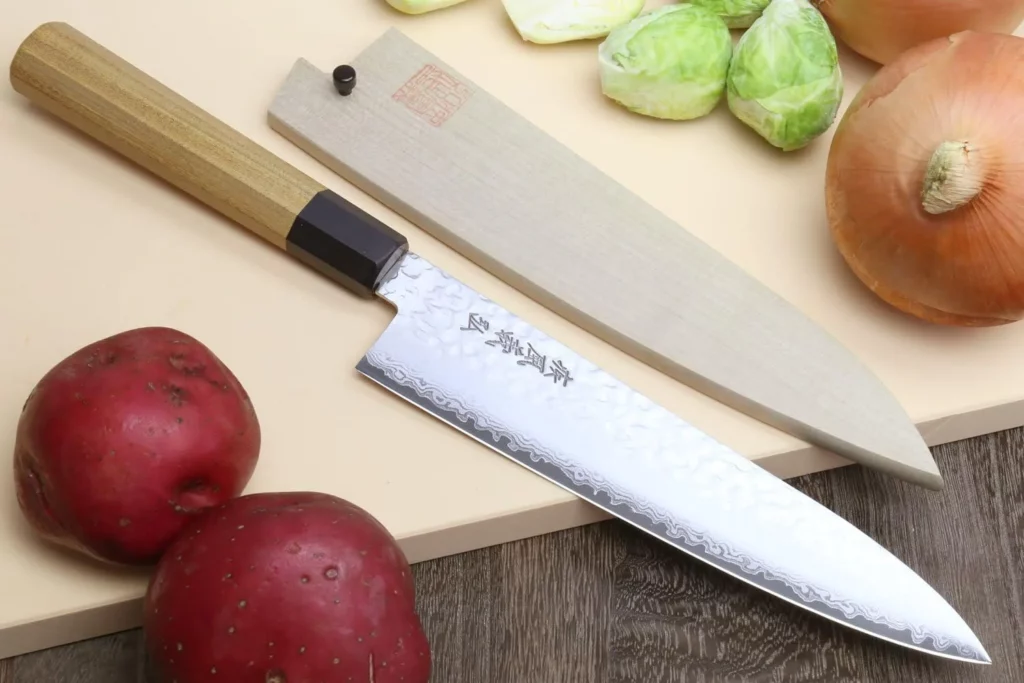
A chef knife, also known as a cook’s knife or French knife, is a versatile and multipurpose kitchen tool designed for a wide range of cutting tasks.
It is often considered the workhorse of the kitchen and is a must-have for both professional chefs and home cooks.
The primary purpose of a chef knife is to make chopping, slicing, and dicing tasks more efficient and precise.
Description of the Unique Features and Design
The chef knife stands out due to its distinct design and features:
- Blade Shape: Chef knives have a long, broad, and gradually curved blade with a pointed tip. This curved design allows for a rocking motion when cutting, making it easier to chop and mince ingredients quickly.
- Blade Length: Chef knife blades typically range from 8 to 10 inches (20 to 25 cm) in length, providing ample space for handling various tasks. Longer chef knives offer a more cutting surface for efficiency.
- Blade Thickness: The blade of a chef knife is relatively thick and sturdy, allowing it to handle a wide variety of ingredients, including tough or dense foods.
- Handle: Chef knives come with ergonomic handles designed for a comfortable and secure grip. The handle’s design ensures that the knife is well-balanced and easy to control.
Explanation of the Specific Tasks a Chef Knife is Best Suited For:
Chef knives are incredibly versatile and are used for a multitude of kitchen tasks, including:
- Chopping: The broad blade and curved edge of the chef knife make it perfect for chopping vegetables, herbs, and other ingredients efficiently. The rocking motion simplifies the chopping process.
- Slicing: Chef knives are excellent for slicing a wide range of foods, from meats and poultry to fruits and vegetables. They create uniform and precise slices with ease.
- Dicing: With their sharp blade and precise control, chef knives are ideal for dicing onions, peppers, and other ingredients into uniform pieces.
- Mincing: Chef knives excel at mincing garlic, herbs, and spices finely, allowing the cook to achieve the desired texture.
- Carving: While carving knives are specialized for presentation, chef knives can also be used to carve poultry and large cuts of meat when necessary.
- General Prep: Chef knives are invaluable for general food preparation, from peeling and trimming to more substantial cutting tasks.
Comparison Between Boning Knife and Chef Knife
| Aspect | Boning Knife | Chef Knife (French Knife) |
|---|---|---|
| Blade Shape | Narrow, pointed, curved, tapers to a point | Wider, deeper, curved belly |
| Flexibility | Flexible, follows contours of meat | Less flexible, moderate flexibility |
| Blade Length | 5 to 7 inches | 6 to 12 inches |
| Blade Width | Narrow, designed for precision | Wider, suitable for a range of tasks |
| Tasks It Excels At | Removing bones, filleting, trimming fat | Chopping, slicing, dicing, mincing, etc. |
| Ideal For | Precision cutting around joints and bones | General kitchen cutting needs |
| Not Ideal For | General cutting, slicing, chopping tasks | Intricate bone-in meat preparation |
| Versatility in Cooking Scenarios | General cutting, slicing, and chopping tasks | Versatile, suitable for various tasks |
FAQs
What is the main advantage of a chef knife (French knife)?
Chef knives are versatile and suitable for a wide range of kitchen tasks, including chopping, slicing, dicing, and mincing. They are often considered the go-to knife for general kitchen cutting needs.
How long are the blades of boning knives and chef knives on average?
Boning knives typically have shorter blades, ranging from 5 to 7 inches, while chef knives have longer blades, often ranging from 6 to 12 inches.
In what cooking scenarios is a boning knife indispensable?
A boning knife is indispensable for butchers, professional chefs, and home cooks who frequently work with meat or fish, especially when intricate bone-in meat preparation is required.
Are there any specific safety precautions when using boning knives due to their sharp, pointed blades?
Yes, users should exercise caution when using boning knives to avoid accidents. Always cut away from your body, and ensure a stable cutting surface.
Can a chef knife be used for boning and filleting tasks like a boning knife?
While a chef knife can perform some of these tasks, it may not be as precise as a boning knife when it comes to intricate bone-in meat preparation.
Which knife should I choose for my kitchen, a boning or chef knife?
Your choice of a knife depends on the specific cooking tasks you frequently undertake. If you work with a lot of meat and bone-in cuts, a boning knife is essential. For more general kitchen cutting needs, a chef knife is a versatile choice.
Wrap Up
The choice between a boning knife and a chef’s knife depends on your cooking needs and preferences.
While the chef’s knife is the kitchen workhorse, versatile, and ideal for a wide range of tasks, the boning knife excels in specialized tasks like deboning and filleting.
Whether you’re a seasoned chef or a home cook, having both knives in your collection offers the best of both worlds.
Ultimately, your culinary skills and the dishes you prepare will dictate which knife becomes your go-to kitchen companion.

